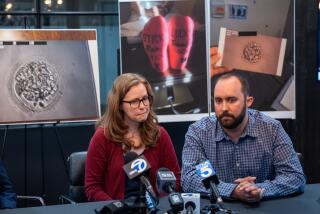Pasadena Clinic Offers Would-Be Parents Fertile Grounds for Hope
- Share via
It’s been four years since Leslie and Lowell Watros began their quest for a family of their own, and their hopes rose last month for the umpteenth time in a new Pasadena infertility clinic.
“I think this will do it,” said Leslie Watros, 30, who has had “10 inseminations, one miscarriage, a million and one ultrasounds and hormonal studies, diagnostic surgery--you name it.”
With them in the waiting room of the Huntington Reproductive Center were a wheelchair-bound 45-year-old paraplegic man and his wife, and a 42-year-old South Pasadena woman who has tried for 17 years to have a baby.
They are among the 15% to 20% of American couples who are infertile. Many of them have been making the rounds of infertility clinics since the early 1980s, when in vitro fertilization was introduced. Today, 177 clinics in the United States offer assisted reproductive treatments, in which eggs are fertilized outside the body or other technology is used to make conception possible. They have produced an estimated 5,000 births.
10 Pregnancies
While there are no established measures of success for such clinics, the three doctors who founded the Huntington Reproductive Center in May call their record of 10 pregnancies in two months from 24 couples an “outstanding achievement.” No babies have been born yet.
Officials at Huntington Memorial Hospital, which is affiliated with the center, attribute its success so far to the doctors’ combination of medical expertise.
The doctors are Joel Batzofin, an obstetrician-gynecologist with special training in male infertility; Paulo Serafini, an obstetrician-gynecologist and reproductive endocrinologist, and William Blank, a urologist and andrologist.
Blank, who joined the center early in July, described andrology as “an emerging medical specialty in male reproductive and sexual function problems.” He recently completed a fellowship in male infertility at Cornell University Medical College in New York and practices in Newport Beach as well as at the Pasadena clinic. Batzofin, Serafini and their staff work full time at the Huntington Reproductive Center.
“This is an unusual service, to be able to meet the needs of either female or male patients,” said Dr. Allen Mathies, president and chief executive officer of Huntington Memorial.
Other procedures to induce pregnancy include artificial insemination; gamete intra-Fallopian transfer, in which the egg and sperm are mixed and returned to the woman’s Fallopian tubes to fertilize; zygote intra-Fallopian transfer, in which an early embryo is returned to the woman’s Fallopian tubes; laser surgery and pelvic reconstructive surgery, and the use of donor embryos, eggs and sperm.
Mathies said the hospital had wanted an infertility clinic when Batzofin and Serafini proposed establishing theirs earlier this year. The hospital provides a laboratory, equipment and staffing for the infertility clinic, which is across the street.
Spokesmen at the American Fertility Society in Birmingham, Ala., and at other infertility clinics said the combination of female and male specialists in one clinic is “desirable, but extremely rare.”
Dr. Robert Schenken, a fertility specialist and professor in the division of reproductive endocrinology and infertility at the University of Texas Health Science Center at San Antonio, called the combination “uncommon.”
‘Rare Breed’
“When you deal with infertile couples, it’s a mistake not to treat both male and female,” Schenken said. “But there are not many urologists who are experts in male infertility. They are a rare breed.”
A spokeswoman for the Jones Institute for Reproductive Medicine in Norfolk, Va., America’s first in vitro clinic, whose founders delivered the country’s first test-tube baby in 1981, said the institute has urologists but no andrologists on its staff.
The Jones Institute, one of the major clinics in the country, according to the American Fertility Society, has treated about 3,200 patients since 1983 with a success rate of between 25% and 28%.
Batzofin and Serafini were associated with infertility clinics at UC Irvine Memorial Hospital, Cedars-Sinai Medical Center and Good Samaritan Hospital, which have produced about 300 babies.
When they established their own clinic in May, many of their first patients were people who had heard of them from other clinics, they said. The doctors said they now have patients from as far away as Sacramento.
Had First Pregnancy
The South Pasadena woman who had tried for 17 years to have a baby had her first pregnancy after being treated at the Huntington Reproductive Center, but miscarried after five weeks. Her 46-year-old husband, who asked that their names not be used, said they are heartened to know that they can conceive, and will try again.
The Watroses, who live in Whittier, said they had been to three clinics in four years before meeting Blank at a meeting of RESOLVE, a support group for infertile couples.
“In those four years, I have given birth and raised a family by fantasizing--and just because my children aren’t here doesn’t make them any less real,” Leslie Watros said.
The Pasadena clinic has recommended a way to treat her husband’s sperm, she said, and “they check ovulation right down to the hour. They have focused more on our problem than other clinics have, and this gives us hope.”
John and Margaret Hebert of Orange read a newspaper article about Blank, who uses a method called electroejaculation to retrieve sperm from men who are unable to father children through normal intercourse.
Most of them, Like Hebert, are victims of spinal cord injuries. He became a paraplegic when he had spinal meningitis 20 years ago.
Similar Devices Used
Blank said he designed the electroejaculator he uses, although similar devices have been tried for many years throughout the world. Officials at Baylor College of Medicine in Houston, Tex., said they are using one of the devices he designed.
Schenken at the University of Texas said he intends to come to Pasadena soon with an associate to study the use of the electroejaculator.
Blank said the device could have a major impact on the lives of hundreds of thousands of men who cannot father children because of spinal cord injuries. Sperm is ejaculated through the use of a mild electrical stimulus and can be immediately implanted in the woman.
“Here, the sperm doesn’t have to be driven to another place to be processed by some clinic you may never have heard of,” Blank said.
Fathering children, he said, is “living, not just surviving.”
‘Quintessence of Life’
Batzofin calls having children “the quintessence of life. Having children is really what life is all about.”
Serafini, a native of Brazil who said he is one of 16 physicians in his family, said most reproductive medicine has focused on women.
“If you compare the knowledge of male and female infertility specialists in the past 10 years, there’s a tremendous gaining of knowledge among female specialists and very, very slow progress in males.”
The doctors said one-third of all infertility problems are due to the woman, one-third to the man and one-third to an interaction of the two. The most common causes of infertility in women are pelvic infections, endometriosis (in which tissue lining the uterus prevents sperm from meeting the egg) and fibroid tumors. Men most commonly have low sperm count and vascular blockages.
Couples Encouraged
The doctors prefer to work with couples, encouraging women to hold the cup when the man’s sperm is released and men to watch such processes as ultrasound aspiration, in which mature eggs are drawn from the follicles that feed into a woman’s Fallopian tubes.
Gayle Norbryhn, a registered nurse who specializes in infertility and who worked with Serafini and Batzofin in other clinics, keeps track of the women’s ovulation cycles, testing them daily until the exact hour when eggs mature.
Norbryhn said she and the doctors often work 14 days without a day off and sometimes as long as 21 days to accommodate the patients’ reproductive cycles.
“They’ve all been on a long, hard road,” Norbryhn said. “They’ve been trying from three to 15 years. For some, it’s almost an obsession.”
The most moving cases, she said, are those in which low-income couples worked and saved for a long time, failed to have a pregnancy with the first try, and then worked and saved again. The cost is an estimated $4,000 to $6,500 for each cycle, including the women’s surgery.
“In one case, both the husband and wife had medical problems, and they miscarried. Then they worked and saved again, and then they had a normal delivery,” Norbryhn said.
‘Stages of Mourning’
In cases of failure, when the couple must give up, she said, “patients seem to go through stages of mourning, as if it’s a death. They go through denial, disbelief, anger, grieving. They have to work through all that.”
But, Batzofin said, “if there’s a way to get them pregnant, we’ll find it.”






